Case Study: Perioperative Assessment and Management of Pediatric Burns
VerifiedAdded on 2021/04/24
|12
|3321
|78
Case Study
AI Summary
This case study focuses on the perioperative assessment and management of a 5-year-old pediatric patient, Zaynab, who sustained a second-degree burn. It meticulously examines the critical aspects of burn care, including airway management, fluid balance, and pain control, emphasizing the unique challenges of treating young patients. The assessment covers the immediate priorities of stabilizing the patient, addressing potential airway issues, and managing fluid resuscitation using established guidelines like the Parkland formula. Pain management strategies are discussed, including pharmacological interventions like acetaminophen, NSAIDs, and opioids, while considering the child's age and potential side effects. Psychological support is also highlighted, recognizing the trauma associated with burns and the importance of family involvement. Ethical and legal considerations, such as parental consent and child abuse reporting, are also addressed. The case study underscores the importance of a multidisciplinary approach to ensure comprehensive care for pediatric burn patients, from initial assessment to psychological support and ethical considerations.
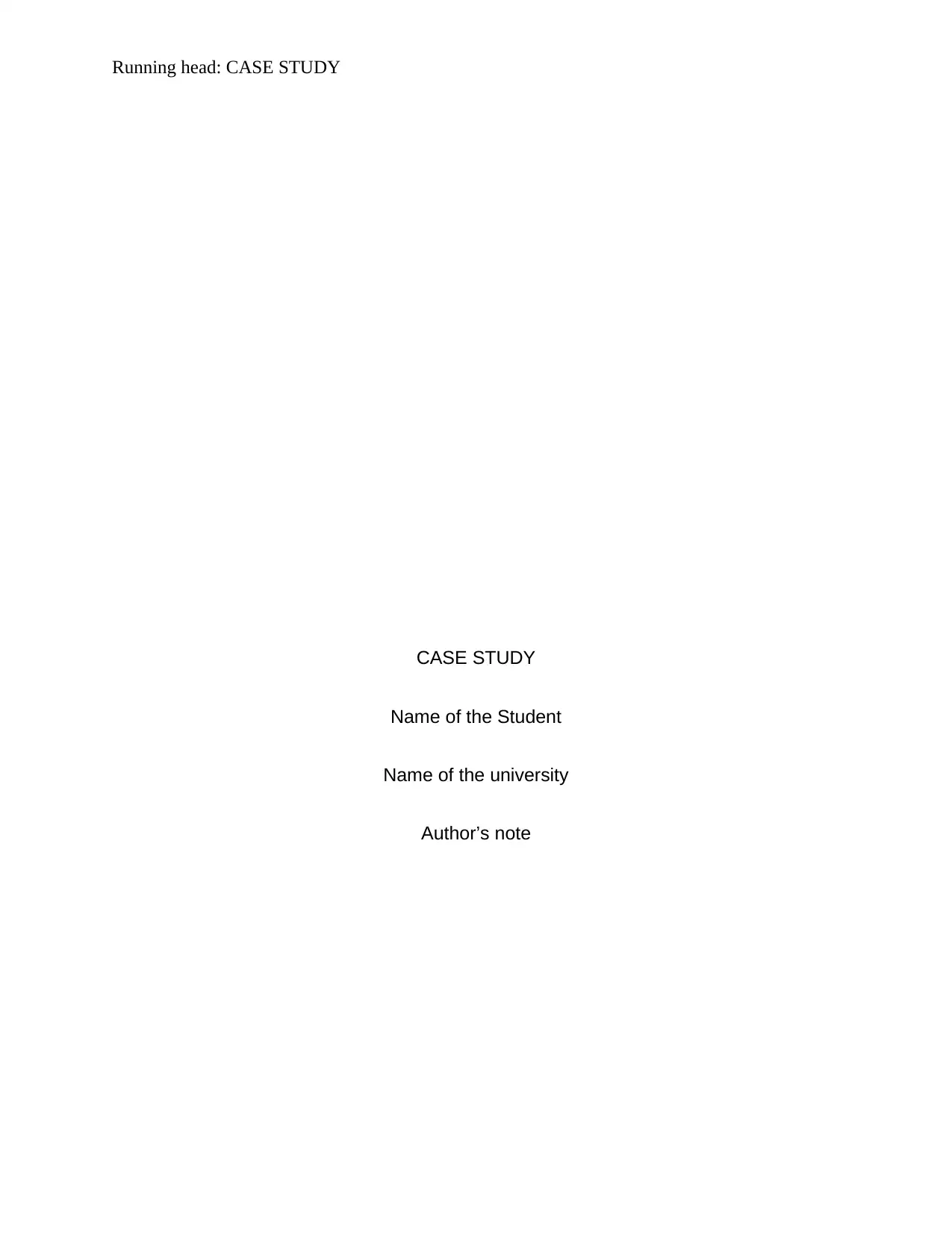
Running head: CASE STUDY
CASE STUDY
Name of the Student
Name of the university
Author’s note
CASE STUDY
Name of the Student
Name of the university
Author’s note
Paraphrase This Document
Need a fresh take? Get an instant paraphrase of this document with our AI Paraphraser

1CASE STUDY
Perioperative assessment
Zaynab is a kid and is vulnerable to slips, falls and burns. They have sensitive
skin and can be life threatening, depending upon the severity of the burn (de Jong et
al.2014). It is evident form the case study that Zaynab was having second degree burn
that involves deep layers beneath the skin, dermis. These burns are painful as they
form blisters and the healing time can take more than three weeks. Pain occurs due to
the release of the inflammatory mediators like prostaglandins and bradykinin triggering
the pain receptors present in the skin. (McBride and Holland 2015). Young children are
physically unstable and are mentally inquisitive, hence burn can bring physical as well
as emotional trauma in the patient. (Bittner et al. 2015). The health care professionals in
charge of the paediatric units should be able to act promptly against any kind of
emergency situations. In order to do this, communication among the multidisciplinary
team is very crucial in order to manage the perioperative care in a manner that is in
compliance with treatment goals of the clinical setting (Krishnamoorthy et al. 2012).
Zaynab is an emergency case; he will not be prepared for any kind of surgical
procedures and hence will require an operating department practitioner (ODP). I order
to apply the anaesthesia it is essential to detect if Zaynab had any histories of allergies.
Pain and trauma can bring about gastric emptying; hence it is necessary to address the
concerns of the child by assessing her facial expression or her voice.
The preliminary assessment of a burn includes the Clearance of the airways,
breathing, and stabilization of the circulation followed by homeostasis. One of the major
parts of the treatment is the pain management (Snell et al. 2013). Regardless of the
Perioperative assessment
Zaynab is a kid and is vulnerable to slips, falls and burns. They have sensitive
skin and can be life threatening, depending upon the severity of the burn (de Jong et
al.2014). It is evident form the case study that Zaynab was having second degree burn
that involves deep layers beneath the skin, dermis. These burns are painful as they
form blisters and the healing time can take more than three weeks. Pain occurs due to
the release of the inflammatory mediators like prostaglandins and bradykinin triggering
the pain receptors present in the skin. (McBride and Holland 2015). Young children are
physically unstable and are mentally inquisitive, hence burn can bring physical as well
as emotional trauma in the patient. (Bittner et al. 2015). The health care professionals in
charge of the paediatric units should be able to act promptly against any kind of
emergency situations. In order to do this, communication among the multidisciplinary
team is very crucial in order to manage the perioperative care in a manner that is in
compliance with treatment goals of the clinical setting (Krishnamoorthy et al. 2012).
Zaynab is an emergency case; he will not be prepared for any kind of surgical
procedures and hence will require an operating department practitioner (ODP). I order
to apply the anaesthesia it is essential to detect if Zaynab had any histories of allergies.
Pain and trauma can bring about gastric emptying; hence it is necessary to address the
concerns of the child by assessing her facial expression or her voice.
The preliminary assessment of a burn includes the Clearance of the airways,
breathing, and stabilization of the circulation followed by homeostasis. One of the major
parts of the treatment is the pain management (Snell et al. 2013). Regardless of the
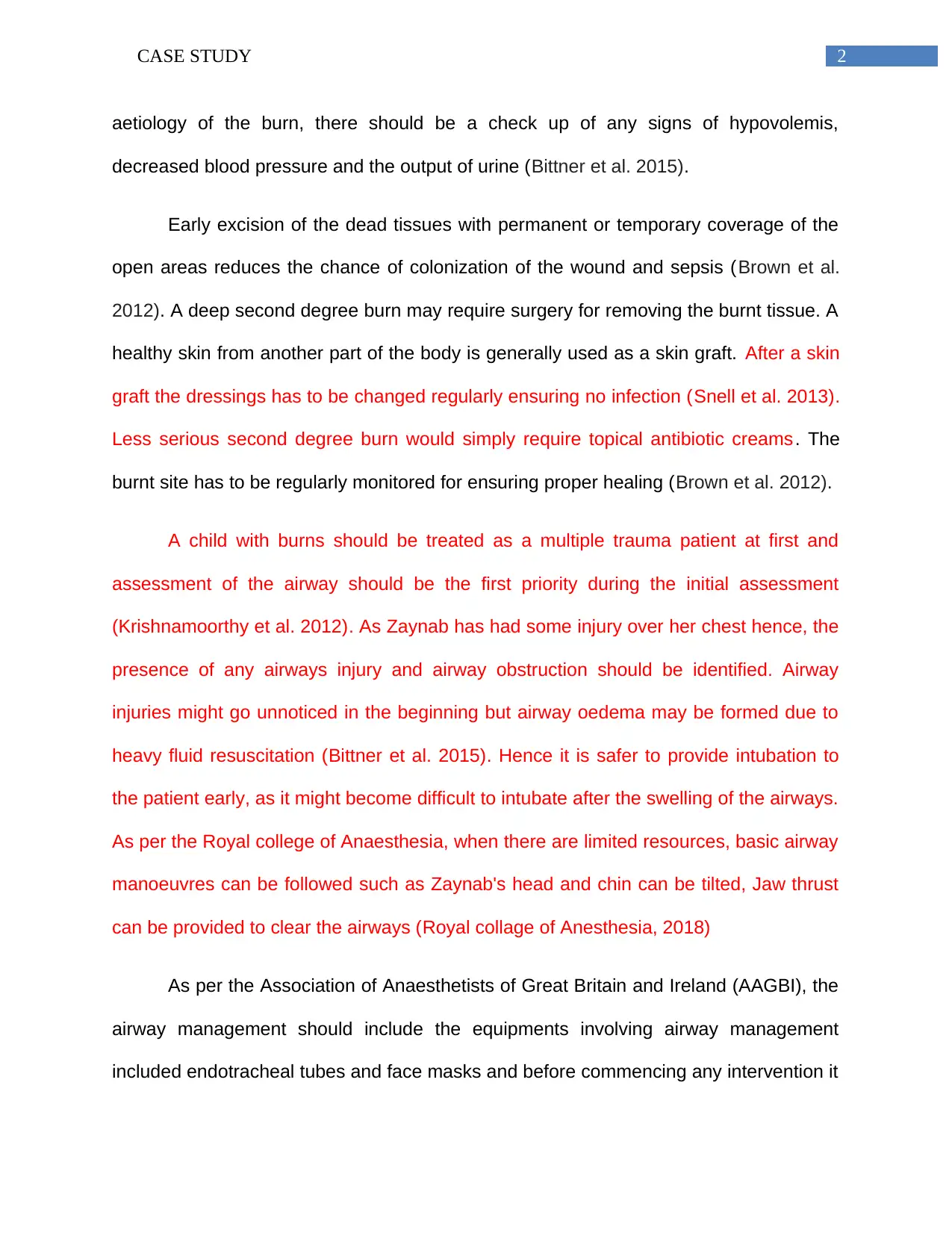
2CASE STUDY
aetiology of the burn, there should be a check up of any signs of hypovolemis,
decreased blood pressure and the output of urine (Bittner et al. 2015).
Early excision of the dead tissues with permanent or temporary coverage of the
open areas reduces the chance of colonization of the wound and sepsis (Brown et al.
2012). A deep second degree burn may require surgery for removing the burnt tissue. A
healthy skin from another part of the body is generally used as a skin graft. After a skin
graft the dressings has to be changed regularly ensuring no infection (Snell et al. 2013).
Less serious second degree burn would simply require topical antibiotic creams. The
burnt site has to be regularly monitored for ensuring proper healing (Brown et al. 2012).
A child with burns should be treated as a multiple trauma patient at first and
assessment of the airway should be the first priority during the initial assessment
(Krishnamoorthy et al. 2012). As Zaynab has had some injury over her chest hence, the
presence of any airways injury and airway obstruction should be identified. Airway
injuries might go unnoticed in the beginning but airway oedema may be formed due to
heavy fluid resuscitation (Bittner et al. 2015). Hence it is safer to provide intubation to
the patient early, as it might become difficult to intubate after the swelling of the airways.
As per the Royal college of Anaesthesia, when there are limited resources, basic airway
manoeuvres can be followed such as Zaynab's head and chin can be tilted, Jaw thrust
can be provided to clear the airways (Royal collage of Anesthesia, 2018)
As per the Association of Anaesthetists of Great Britain and Ireland (AAGBI), the
airway management should include the equipments involving airway management
included endotracheal tubes and face masks and before commencing any intervention it
aetiology of the burn, there should be a check up of any signs of hypovolemis,
decreased blood pressure and the output of urine (Bittner et al. 2015).
Early excision of the dead tissues with permanent or temporary coverage of the
open areas reduces the chance of colonization of the wound and sepsis (Brown et al.
2012). A deep second degree burn may require surgery for removing the burnt tissue. A
healthy skin from another part of the body is generally used as a skin graft. After a skin
graft the dressings has to be changed regularly ensuring no infection (Snell et al. 2013).
Less serious second degree burn would simply require topical antibiotic creams. The
burnt site has to be regularly monitored for ensuring proper healing (Brown et al. 2012).
A child with burns should be treated as a multiple trauma patient at first and
assessment of the airway should be the first priority during the initial assessment
(Krishnamoorthy et al. 2012). As Zaynab has had some injury over her chest hence, the
presence of any airways injury and airway obstruction should be identified. Airway
injuries might go unnoticed in the beginning but airway oedema may be formed due to
heavy fluid resuscitation (Bittner et al. 2015). Hence it is safer to provide intubation to
the patient early, as it might become difficult to intubate after the swelling of the airways.
As per the Royal college of Anaesthesia, when there are limited resources, basic airway
manoeuvres can be followed such as Zaynab's head and chin can be tilted, Jaw thrust
can be provided to clear the airways (Royal collage of Anesthesia, 2018)
As per the Association of Anaesthetists of Great Britain and Ireland (AAGBI), the
airway management should include the equipments involving airway management
included endotracheal tubes and face masks and before commencing any intervention it
⊘ This is a preview!⊘
Do you want full access?
Subscribe today to unlock all pages.

Trusted by 1+ million students worldwide
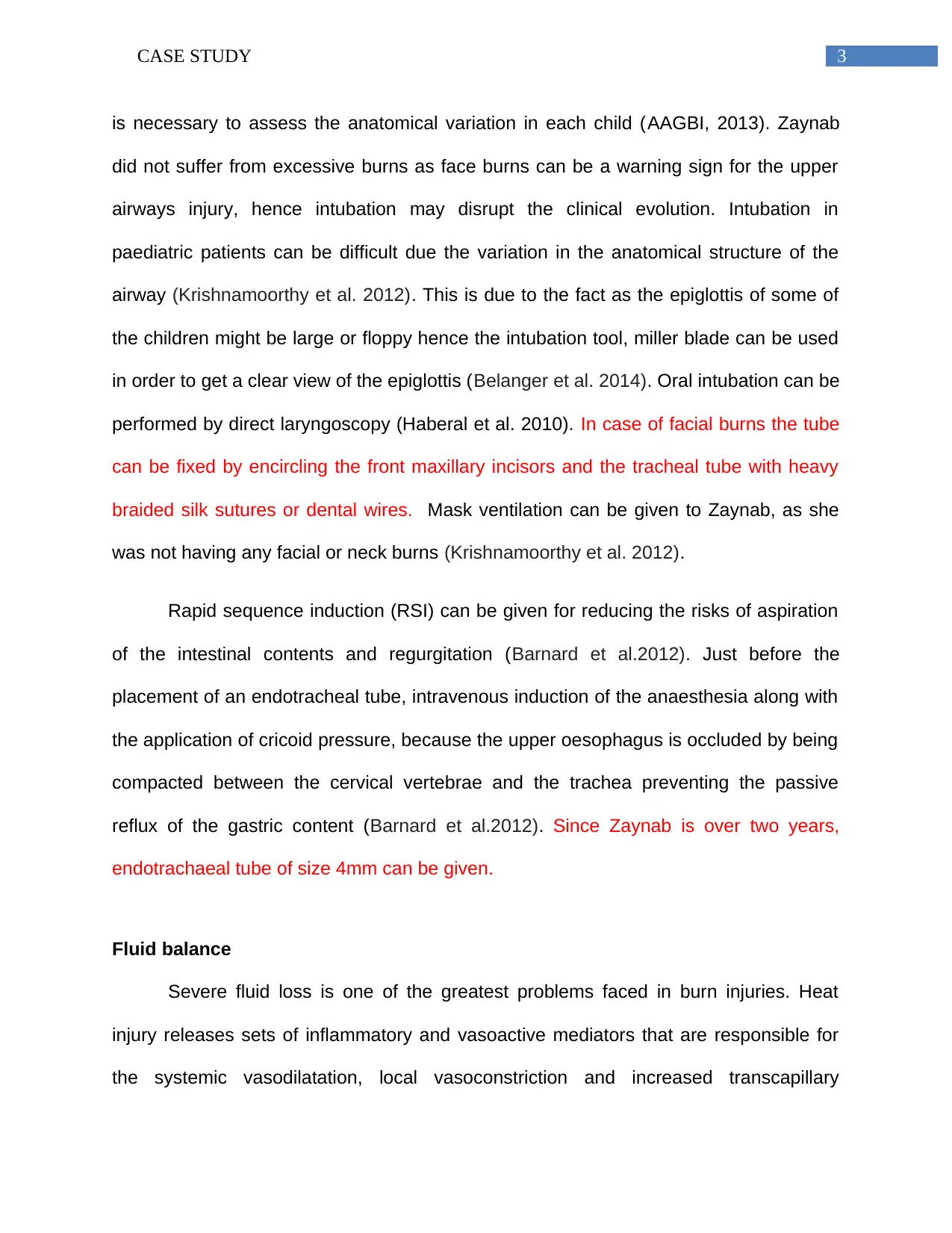
3CASE STUDY
is necessary to assess the anatomical variation in each child (AAGBI, 2013). Zaynab
did not suffer from excessive burns as face burns can be a warning sign for the upper
airways injury, hence intubation may disrupt the clinical evolution. Intubation in
paediatric patients can be difficult due the variation in the anatomical structure of the
airway (Krishnamoorthy et al. 2012). This is due to the fact as the epiglottis of some of
the children might be large or floppy hence the intubation tool, miller blade can be used
in order to get a clear view of the epiglottis (Belanger et al. 2014). Oral intubation can be
performed by direct laryngoscopy (Haberal et al. 2010). In case of facial burns the tube
can be fixed by encircling the front maxillary incisors and the tracheal tube with heavy
braided silk sutures or dental wires. Mask ventilation can be given to Zaynab, as she
was not having any facial or neck burns (Krishnamoorthy et al. 2012).
Rapid sequence induction (RSI) can be given for reducing the risks of aspiration
of the intestinal contents and regurgitation (Barnard et al.2012). Just before the
placement of an endotracheal tube, intravenous induction of the anaesthesia along with
the application of cricoid pressure, because the upper oesophagus is occluded by being
compacted between the cervical vertebrae and the trachea preventing the passive
reflux of the gastric content (Barnard et al.2012). Since Zaynab is over two years,
endotrachaeal tube of size 4mm can be given.
Fluid balance
Severe fluid loss is one of the greatest problems faced in burn injuries. Heat
injury releases sets of inflammatory and vasoactive mediators that are responsible for
the systemic vasodilatation, local vasoconstriction and increased transcapillary
is necessary to assess the anatomical variation in each child (AAGBI, 2013). Zaynab
did not suffer from excessive burns as face burns can be a warning sign for the upper
airways injury, hence intubation may disrupt the clinical evolution. Intubation in
paediatric patients can be difficult due the variation in the anatomical structure of the
airway (Krishnamoorthy et al. 2012). This is due to the fact as the epiglottis of some of
the children might be large or floppy hence the intubation tool, miller blade can be used
in order to get a clear view of the epiglottis (Belanger et al. 2014). Oral intubation can be
performed by direct laryngoscopy (Haberal et al. 2010). In case of facial burns the tube
can be fixed by encircling the front maxillary incisors and the tracheal tube with heavy
braided silk sutures or dental wires. Mask ventilation can be given to Zaynab, as she
was not having any facial or neck burns (Krishnamoorthy et al. 2012).
Rapid sequence induction (RSI) can be given for reducing the risks of aspiration
of the intestinal contents and regurgitation (Barnard et al.2012). Just before the
placement of an endotracheal tube, intravenous induction of the anaesthesia along with
the application of cricoid pressure, because the upper oesophagus is occluded by being
compacted between the cervical vertebrae and the trachea preventing the passive
reflux of the gastric content (Barnard et al.2012). Since Zaynab is over two years,
endotrachaeal tube of size 4mm can be given.
Fluid balance
Severe fluid loss is one of the greatest problems faced in burn injuries. Heat
injury releases sets of inflammatory and vasoactive mediators that are responsible for
the systemic vasodilatation, local vasoconstriction and increased transcapillary
Paraphrase This Document
Need a fresh take? Get an instant paraphrase of this document with our AI Paraphraser
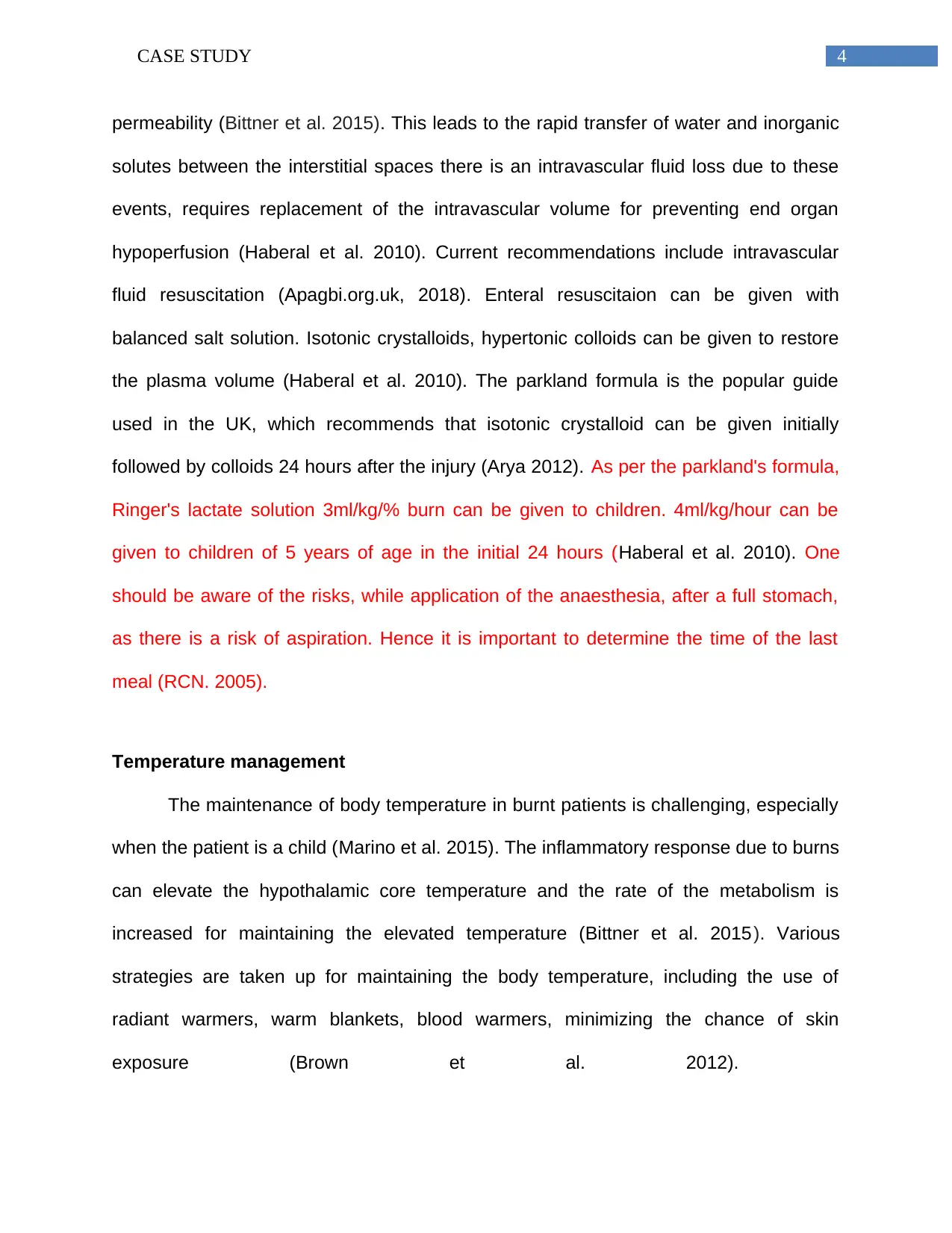
4CASE STUDY
permeability (Bittner et al. 2015). This leads to the rapid transfer of water and inorganic
solutes between the interstitial spaces there is an intravascular fluid loss due to these
events, requires replacement of the intravascular volume for preventing end organ
hypoperfusion (Haberal et al. 2010). Current recommendations include intravascular
fluid resuscitation (Apagbi.org.uk, 2018). Enteral resuscitaion can be given with
balanced salt solution. Isotonic crystalloids, hypertonic colloids can be given to restore
the plasma volume (Haberal et al. 2010). The parkland formula is the popular guide
used in the UK, which recommends that isotonic crystalloid can be given initially
followed by colloids 24 hours after the injury (Arya 2012). As per the parkland's formula,
Ringer's lactate solution 3ml/kg/% burn can be given to children. 4ml/kg/hour can be
given to children of 5 years of age in the initial 24 hours (Haberal et al. 2010). One
should be aware of the risks, while application of the anaesthesia, after a full stomach,
as there is a risk of aspiration. Hence it is important to determine the time of the last
meal (RCN. 2005).
Temperature management
The maintenance of body temperature in burnt patients is challenging, especially
when the patient is a child (Marino et al. 2015). The inflammatory response due to burns
can elevate the hypothalamic core temperature and the rate of the metabolism is
increased for maintaining the elevated temperature (Bittner et al. 2015). Various
strategies are taken up for maintaining the body temperature, including the use of
radiant warmers, warm blankets, blood warmers, minimizing the chance of skin
exposure (Brown et al. 2012).
permeability (Bittner et al. 2015). This leads to the rapid transfer of water and inorganic
solutes between the interstitial spaces there is an intravascular fluid loss due to these
events, requires replacement of the intravascular volume for preventing end organ
hypoperfusion (Haberal et al. 2010). Current recommendations include intravascular
fluid resuscitation (Apagbi.org.uk, 2018). Enteral resuscitaion can be given with
balanced salt solution. Isotonic crystalloids, hypertonic colloids can be given to restore
the plasma volume (Haberal et al. 2010). The parkland formula is the popular guide
used in the UK, which recommends that isotonic crystalloid can be given initially
followed by colloids 24 hours after the injury (Arya 2012). As per the parkland's formula,
Ringer's lactate solution 3ml/kg/% burn can be given to children. 4ml/kg/hour can be
given to children of 5 years of age in the initial 24 hours (Haberal et al. 2010). One
should be aware of the risks, while application of the anaesthesia, after a full stomach,
as there is a risk of aspiration. Hence it is important to determine the time of the last
meal (RCN. 2005).
Temperature management
The maintenance of body temperature in burnt patients is challenging, especially
when the patient is a child (Marino et al. 2015). The inflammatory response due to burns
can elevate the hypothalamic core temperature and the rate of the metabolism is
increased for maintaining the elevated temperature (Bittner et al. 2015). Various
strategies are taken up for maintaining the body temperature, including the use of
radiant warmers, warm blankets, blood warmers, minimizing the chance of skin
exposure (Brown et al. 2012).
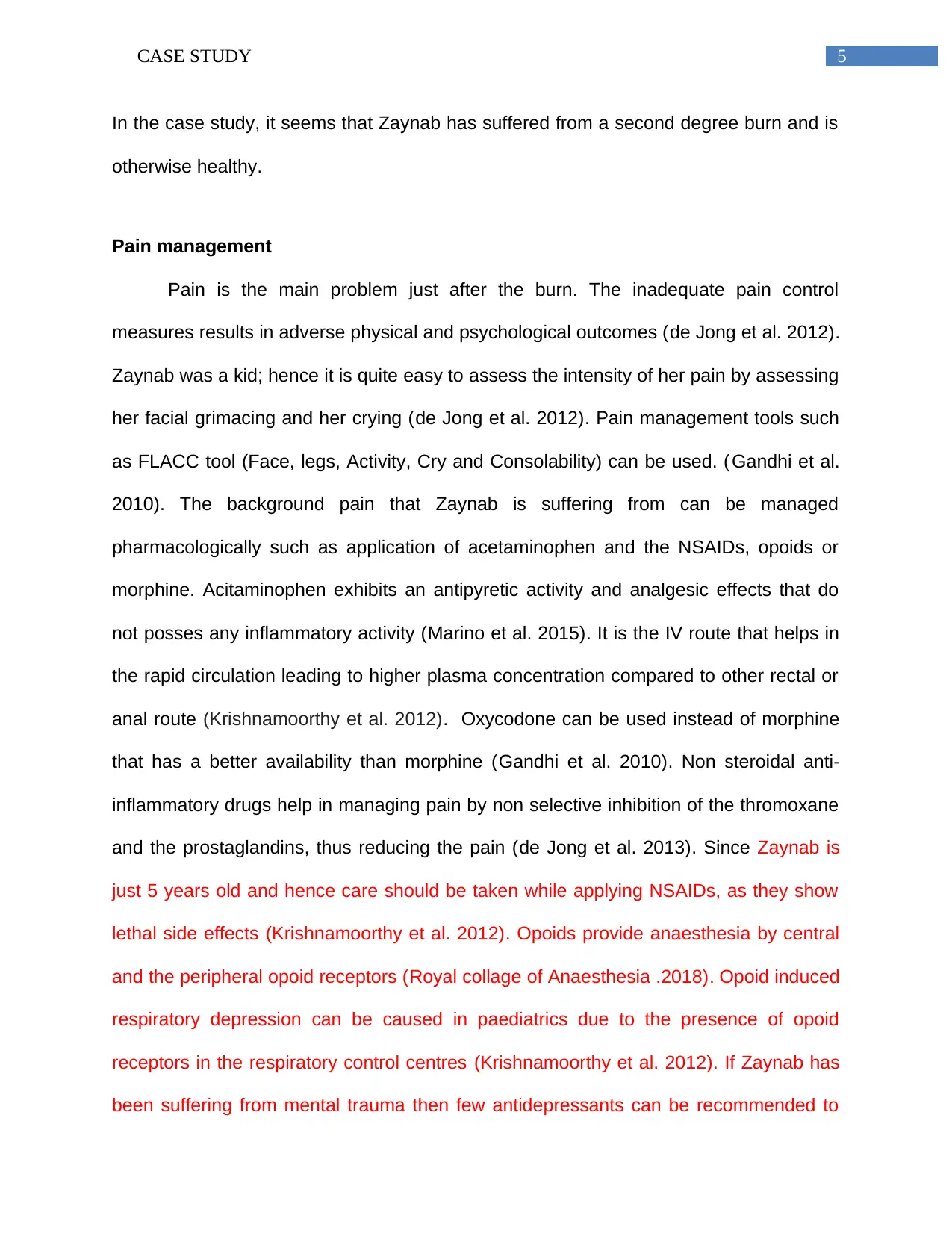
5CASE STUDY
In the case study, it seems that Zaynab has suffered from a second degree burn and is
otherwise healthy.
Pain management
Pain is the main problem just after the burn. The inadequate pain control
measures results in adverse physical and psychological outcomes (de Jong et al. 2012).
Zaynab was a kid; hence it is quite easy to assess the intensity of her pain by assessing
her facial grimacing and her crying (de Jong et al. 2012). Pain management tools such
as FLACC tool (Face, legs, Activity, Cry and Consolability) can be used. ( Gandhi et al.
2010). The background pain that Zaynab is suffering from can be managed
pharmacologically such as application of acetaminophen and the NSAIDs, opoids or
morphine. Acitaminophen exhibits an antipyretic activity and analgesic effects that do
not posses any inflammatory activity (Marino et al. 2015). It is the IV route that helps in
the rapid circulation leading to higher plasma concentration compared to other rectal or
anal route (Krishnamoorthy et al. 2012). Oxycodone can be used instead of morphine
that has a better availability than morphine (Gandhi et al. 2010). Non steroidal anti-
inflammatory drugs help in managing pain by non selective inhibition of the thromoxane
and the prostaglandins, thus reducing the pain (de Jong et al. 2013). Since Zaynab is
just 5 years old and hence care should be taken while applying NSAIDs, as they show
lethal side effects (Krishnamoorthy et al. 2012). Opoids provide anaesthesia by central
and the peripheral opoid receptors (Royal collage of Anaesthesia .2018). Opoid induced
respiratory depression can be caused in paediatrics due to the presence of opoid
receptors in the respiratory control centres (Krishnamoorthy et al. 2012). If Zaynab has
been suffering from mental trauma then few antidepressants can be recommended to
In the case study, it seems that Zaynab has suffered from a second degree burn and is
otherwise healthy.
Pain management
Pain is the main problem just after the burn. The inadequate pain control
measures results in adverse physical and psychological outcomes (de Jong et al. 2012).
Zaynab was a kid; hence it is quite easy to assess the intensity of her pain by assessing
her facial grimacing and her crying (de Jong et al. 2012). Pain management tools such
as FLACC tool (Face, legs, Activity, Cry and Consolability) can be used. ( Gandhi et al.
2010). The background pain that Zaynab is suffering from can be managed
pharmacologically such as application of acetaminophen and the NSAIDs, opoids or
morphine. Acitaminophen exhibits an antipyretic activity and analgesic effects that do
not posses any inflammatory activity (Marino et al. 2015). It is the IV route that helps in
the rapid circulation leading to higher plasma concentration compared to other rectal or
anal route (Krishnamoorthy et al. 2012). Oxycodone can be used instead of morphine
that has a better availability than morphine (Gandhi et al. 2010). Non steroidal anti-
inflammatory drugs help in managing pain by non selective inhibition of the thromoxane
and the prostaglandins, thus reducing the pain (de Jong et al. 2013). Since Zaynab is
just 5 years old and hence care should be taken while applying NSAIDs, as they show
lethal side effects (Krishnamoorthy et al. 2012). Opoids provide anaesthesia by central
and the peripheral opoid receptors (Royal collage of Anaesthesia .2018). Opoid induced
respiratory depression can be caused in paediatrics due to the presence of opoid
receptors in the respiratory control centres (Krishnamoorthy et al. 2012). If Zaynab has
been suffering from mental trauma then few antidepressants can be recommended to
⊘ This is a preview!⊘
Do you want full access?
Subscribe today to unlock all pages.

Trusted by 1+ million students worldwide
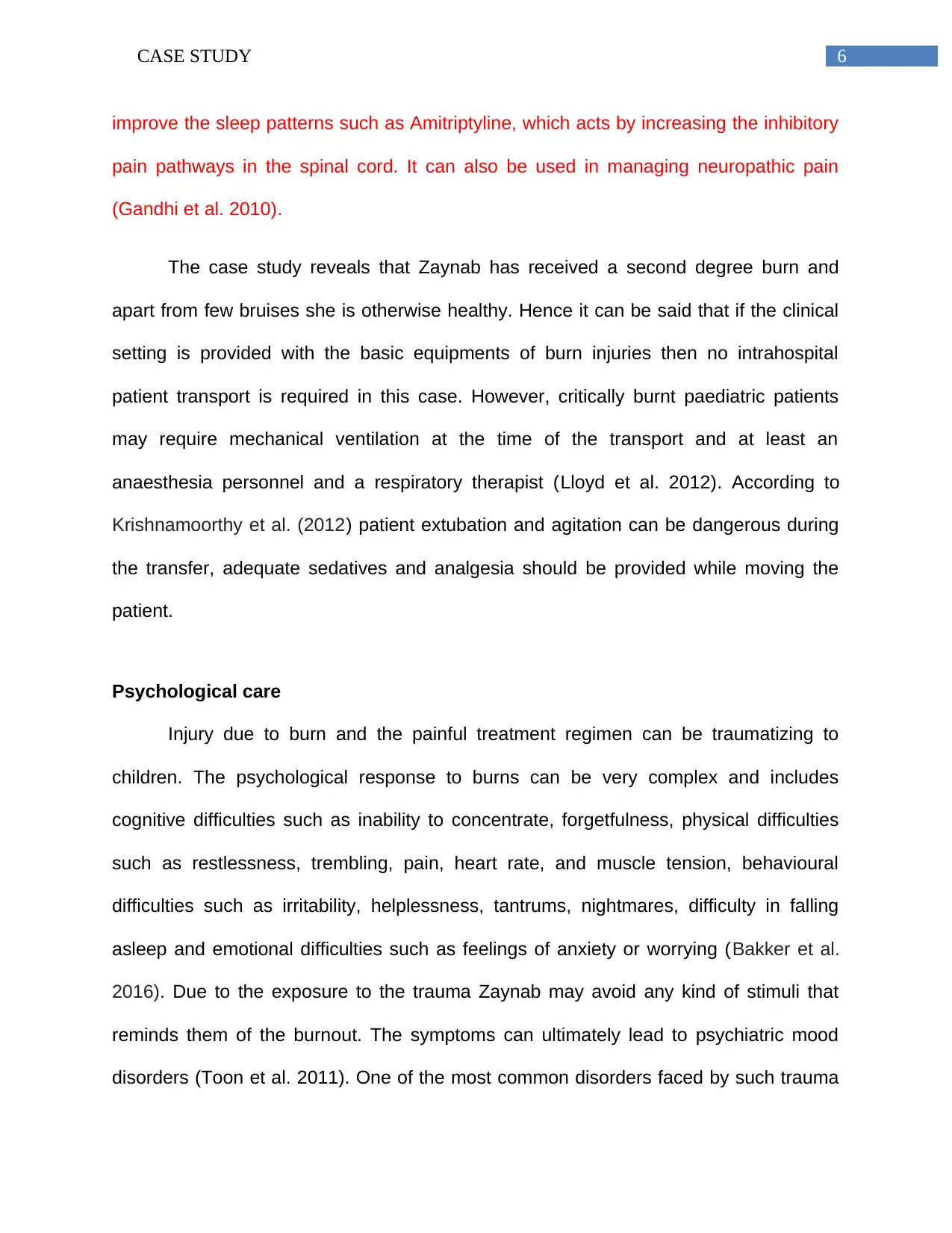
6CASE STUDY
improve the sleep patterns such as Amitriptyline, which acts by increasing the inhibitory
pain pathways in the spinal cord. It can also be used in managing neuropathic pain
(Gandhi et al. 2010).
The case study reveals that Zaynab has received a second degree burn and
apart from few bruises she is otherwise healthy. Hence it can be said that if the clinical
setting is provided with the basic equipments of burn injuries then no intrahospital
patient transport is required in this case. However, critically burnt paediatric patients
may require mechanical ventilation at the time of the transport and at least an
anaesthesia personnel and a respiratory therapist (Lloyd et al. 2012). According to
Krishnamoorthy et al. (2012) patient extubation and agitation can be dangerous during
the transfer, adequate sedatives and analgesia should be provided while moving the
patient.
Psychological care
Injury due to burn and the painful treatment regimen can be traumatizing to
children. The psychological response to burns can be very complex and includes
cognitive difficulties such as inability to concentrate, forgetfulness, physical difficulties
such as restlessness, trembling, pain, heart rate, and muscle tension, behavioural
difficulties such as irritability, helplessness, tantrums, nightmares, difficulty in falling
asleep and emotional difficulties such as feelings of anxiety or worrying (Bakker et al.
2016). Due to the exposure to the trauma Zaynab may avoid any kind of stimuli that
reminds them of the burnout. The symptoms can ultimately lead to psychiatric mood
disorders (Toon et al. 2011). One of the most common disorders faced by such trauma
improve the sleep patterns such as Amitriptyline, which acts by increasing the inhibitory
pain pathways in the spinal cord. It can also be used in managing neuropathic pain
(Gandhi et al. 2010).
The case study reveals that Zaynab has received a second degree burn and
apart from few bruises she is otherwise healthy. Hence it can be said that if the clinical
setting is provided with the basic equipments of burn injuries then no intrahospital
patient transport is required in this case. However, critically burnt paediatric patients
may require mechanical ventilation at the time of the transport and at least an
anaesthesia personnel and a respiratory therapist (Lloyd et al. 2012). According to
Krishnamoorthy et al. (2012) patient extubation and agitation can be dangerous during
the transfer, adequate sedatives and analgesia should be provided while moving the
patient.
Psychological care
Injury due to burn and the painful treatment regimen can be traumatizing to
children. The psychological response to burns can be very complex and includes
cognitive difficulties such as inability to concentrate, forgetfulness, physical difficulties
such as restlessness, trembling, pain, heart rate, and muscle tension, behavioural
difficulties such as irritability, helplessness, tantrums, nightmares, difficulty in falling
asleep and emotional difficulties such as feelings of anxiety or worrying (Bakker et al.
2016). Due to the exposure to the trauma Zaynab may avoid any kind of stimuli that
reminds them of the burnout. The symptoms can ultimately lead to psychiatric mood
disorders (Toon et al. 2011). One of the most common disorders faced by such trauma
Paraphrase This Document
Need a fresh take? Get an instant paraphrase of this document with our AI Paraphraser

7CASE STUDY
is the acute stress disorders and post traumatic disorders (Krishnamoorthy et al. 2012).
In order to reduce the anxiety of the child it is necessary for the parents to accompany
the child in all conditions. Paediatrics burn units should need a child psychiatrist in order
to treat depression, anxiety, oppositional behaviour in the child (Toon et al. 2011). The
most significant psychological approach is the family support (Bakker et al. 2016).
Zaynab's father and the mother should play the critical role in dealing out with the
emotional distress, grief and the pain coping strategies and other mental health issues
of the kid.
Legal and the ethical issues
The case study reveals the fact that Zaynab had spilled a hot soup over her body
while playing near the dining table at the time of lunch. In this context it can be said that
her parents would have been more careful as Zaynab is just a small kid. It can also be
found that when Zaynab was taken in the anaesthetic room, her mother did not offer
much help even after seeing her child crying out of pain. Any kinds of maltreatment or
negligence of care can pose a detrimental effect in the physical and the mental well
being of a child that can affect Zaynab's recovery. The Child abuse Prevention and the
Treatment act mandates the reporting of any suspected or confirmed abuse
(Department of Health. 2018).
Consent is the legal expression of the ethical principles of autonomy (Attard-
Montalto 2001). Zaynab cannot be considered as Gillick competent for giving consent to
any kind of medical examination and treatment and hence it is the mother that has to
take the initiative (Griffith 2016). Some of the key ethical general principles that the
is the acute stress disorders and post traumatic disorders (Krishnamoorthy et al. 2012).
In order to reduce the anxiety of the child it is necessary for the parents to accompany
the child in all conditions. Paediatrics burn units should need a child psychiatrist in order
to treat depression, anxiety, oppositional behaviour in the child (Toon et al. 2011). The
most significant psychological approach is the family support (Bakker et al. 2016).
Zaynab's father and the mother should play the critical role in dealing out with the
emotional distress, grief and the pain coping strategies and other mental health issues
of the kid.
Legal and the ethical issues
The case study reveals the fact that Zaynab had spilled a hot soup over her body
while playing near the dining table at the time of lunch. In this context it can be said that
her parents would have been more careful as Zaynab is just a small kid. It can also be
found that when Zaynab was taken in the anaesthetic room, her mother did not offer
much help even after seeing her child crying out of pain. Any kinds of maltreatment or
negligence of care can pose a detrimental effect in the physical and the mental well
being of a child that can affect Zaynab's recovery. The Child abuse Prevention and the
Treatment act mandates the reporting of any suspected or confirmed abuse
(Department of Health. 2018).
Consent is the legal expression of the ethical principles of autonomy (Attard-
Montalto 2001). Zaynab cannot be considered as Gillick competent for giving consent to
any kind of medical examination and treatment and hence it is the mother that has to
take the initiative (Griffith 2016). Some of the key ethical general principles that the
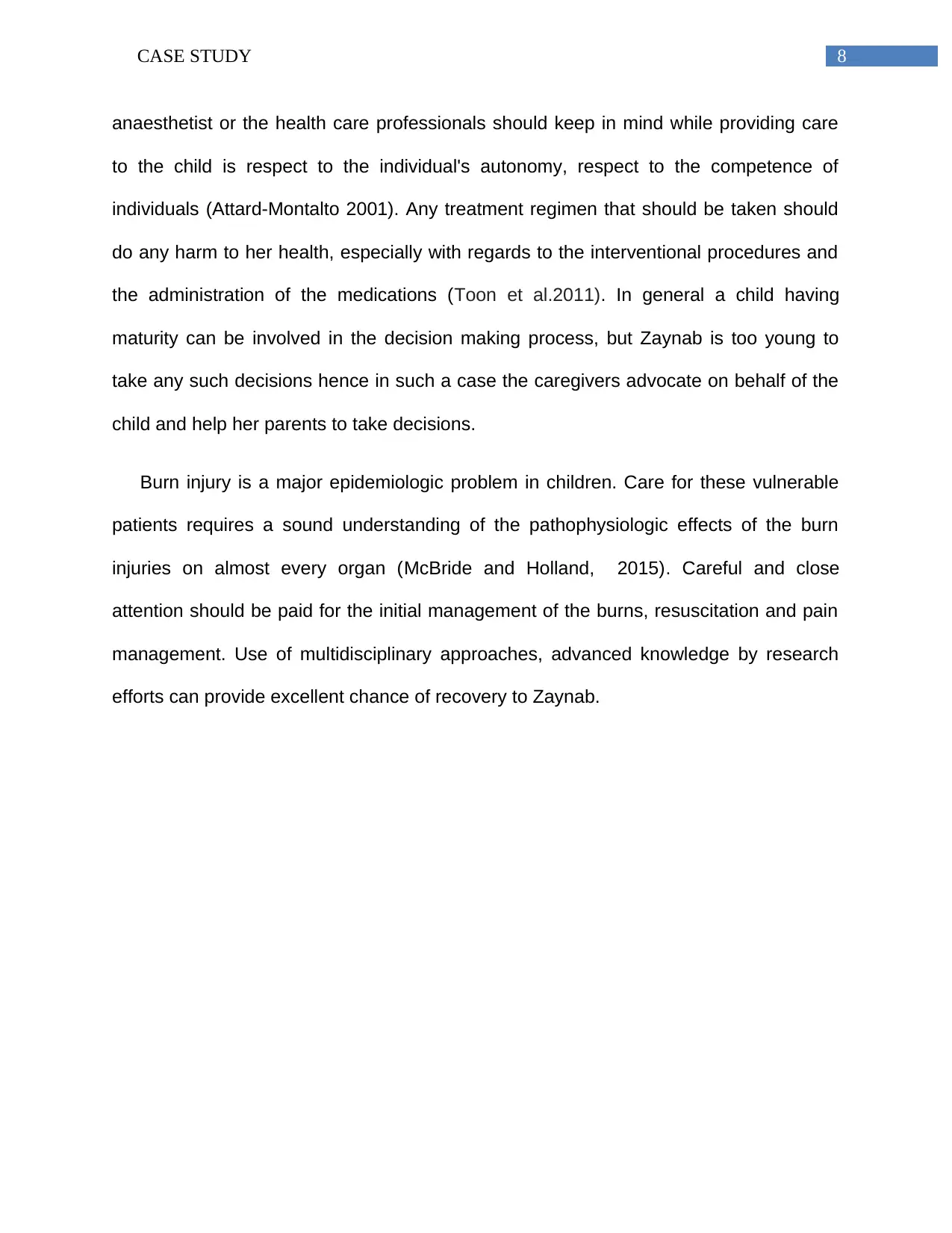
8CASE STUDY
anaesthetist or the health care professionals should keep in mind while providing care
to the child is respect to the individual's autonomy, respect to the competence of
individuals (Attard-Montalto 2001). Any treatment regimen that should be taken should
do any harm to her health, especially with regards to the interventional procedures and
the administration of the medications (Toon et al.2011). In general a child having
maturity can be involved in the decision making process, but Zaynab is too young to
take any such decisions hence in such a case the caregivers advocate on behalf of the
child and help her parents to take decisions.
Burn injury is a major epidemiologic problem in children. Care for these vulnerable
patients requires a sound understanding of the pathophysiologic effects of the burn
injuries on almost every organ (McBride and Holland, 2015). Careful and close
attention should be paid for the initial management of the burns, resuscitation and pain
management. Use of multidisciplinary approaches, advanced knowledge by research
efforts can provide excellent chance of recovery to Zaynab.
anaesthetist or the health care professionals should keep in mind while providing care
to the child is respect to the individual's autonomy, respect to the competence of
individuals (Attard-Montalto 2001). Any treatment regimen that should be taken should
do any harm to her health, especially with regards to the interventional procedures and
the administration of the medications (Toon et al.2011). In general a child having
maturity can be involved in the decision making process, but Zaynab is too young to
take any such decisions hence in such a case the caregivers advocate on behalf of the
child and help her parents to take decisions.
Burn injury is a major epidemiologic problem in children. Care for these vulnerable
patients requires a sound understanding of the pathophysiologic effects of the burn
injuries on almost every organ (McBride and Holland, 2015). Careful and close
attention should be paid for the initial management of the burns, resuscitation and pain
management. Use of multidisciplinary approaches, advanced knowledge by research
efforts can provide excellent chance of recovery to Zaynab.
⊘ This is a preview!⊘
Do you want full access?
Subscribe today to unlock all pages.

Trusted by 1+ million students worldwide
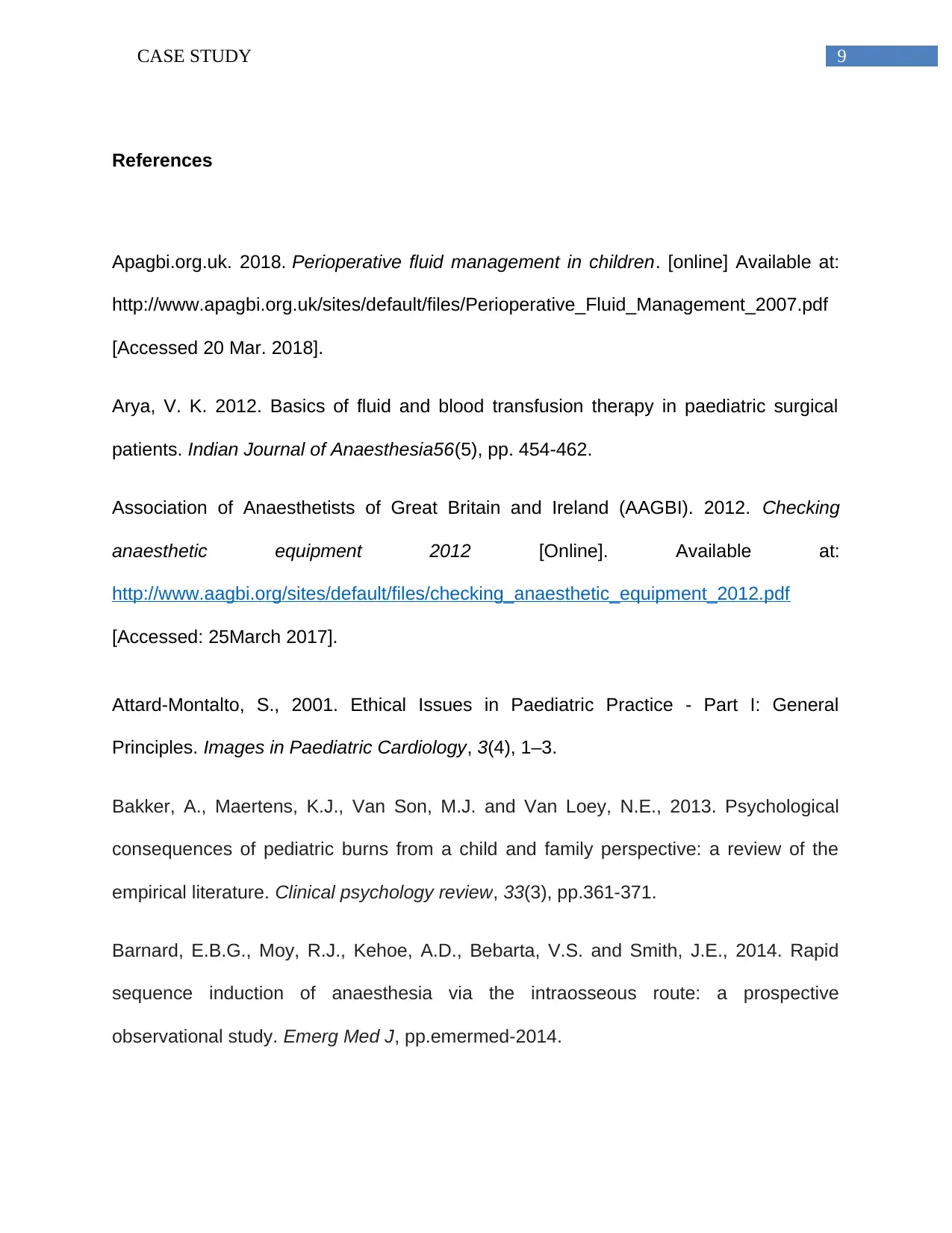
9CASE STUDY
References
Apagbi.org.uk. 2018. Perioperative fluid management in children. [online] Available at:
http://www.apagbi.org.uk/sites/default/files/Perioperative_Fluid_Management_2007.pdf
[Accessed 20 Mar. 2018].
Arya, V. K. 2012. Basics of fluid and blood transfusion therapy in paediatric surgical
patients. Indian Journal of Anaesthesia56(5), pp. 454-462.
Association of Anaesthetists of Great Britain and Ireland (AAGBI). 2012. Checking
anaesthetic equipment 2012 [Online]. Available at:
http://www.aagbi.org/sites/default/files/checking_anaesthetic_equipment_2012.pdf
[Accessed: 25March 2017].
Attard-Montalto, S., 2001. Ethical Issues in Paediatric Practice - Part I: General
Principles. Images in Paediatric Cardiology, 3(4), 1–3.
Bakker, A., Maertens, K.J., Van Son, M.J. and Van Loey, N.E., 2013. Psychological
consequences of pediatric burns from a child and family perspective: a review of the
empirical literature. Clinical psychology review, 33(3), pp.361-371.
Barnard, E.B.G., Moy, R.J., Kehoe, A.D., Bebarta, V.S. and Smith, J.E., 2014. Rapid
sequence induction of anaesthesia via the intraosseous route: a prospective
observational study. Emerg Med J, pp.emermed-2014.
References
Apagbi.org.uk. 2018. Perioperative fluid management in children. [online] Available at:
http://www.apagbi.org.uk/sites/default/files/Perioperative_Fluid_Management_2007.pdf
[Accessed 20 Mar. 2018].
Arya, V. K. 2012. Basics of fluid and blood transfusion therapy in paediatric surgical
patients. Indian Journal of Anaesthesia56(5), pp. 454-462.
Association of Anaesthetists of Great Britain and Ireland (AAGBI). 2012. Checking
anaesthetic equipment 2012 [Online]. Available at:
http://www.aagbi.org/sites/default/files/checking_anaesthetic_equipment_2012.pdf
[Accessed: 25March 2017].
Attard-Montalto, S., 2001. Ethical Issues in Paediatric Practice - Part I: General
Principles. Images in Paediatric Cardiology, 3(4), 1–3.
Bakker, A., Maertens, K.J., Van Son, M.J. and Van Loey, N.E., 2013. Psychological
consequences of pediatric burns from a child and family perspective: a review of the
empirical literature. Clinical psychology review, 33(3), pp.361-371.
Barnard, E.B.G., Moy, R.J., Kehoe, A.D., Bebarta, V.S. and Smith, J.E., 2014. Rapid
sequence induction of anaesthesia via the intraosseous route: a prospective
observational study. Emerg Med J, pp.emermed-2014.
Paraphrase This Document
Need a fresh take? Get an instant paraphrase of this document with our AI Paraphraser

10CASE STUDY
Bittner, E.A., Shank, E., Woodson, L. and Martyn, J.J., 2015. Acute and perioperative
care of the burn-injured patient. Anesthesiology: The Journal of the American Society of
Anesthesiologists, 122(2), pp.448-464.
Brown, N.J., Rodger, S., Ware, R.S., Kimble, R.M. and Cuttle, L., 2012. Efficacy of a
children’s procedural preparation and distraction device on healing in acute burn wound
care procedures: study protocol for a randomized controlled trial. Trials, 13(1), p.238.
de Jong, A.E., Bremer, M., van Komen, R., Vanbrabant, L., Schuurmans, M.,
Middelkoop, E. and van Loey, N., 2014. Pain in young children with burns: extent,
course and influencing factors. Burns, 40(1), pp.38-47.
Department of health (2018). Working together to safeguard children. [online] Available
at: https://www.gov.uk/government/uploads/system/uploads/attachment_data/file/
592101/Working_Together_to_Safeguard_Children_20170213.pdf [Accessed 21 Mar.
2018].
Gandhi, M., Thomson, C., Lord, D. and Enoch, S., 2010. Management of pain in
children with burns. International journal of pediatrics, 2010.
Griffith, R., 2016. What is Gillick competence?. Human vaccines &
immunotherapeutics, 12(1), pp.244-247.
Haberal, M., Sakallioglu Abali, A. E., & Karakayali, H., 2010. Fluid management in major
burn injuries. Indian Journal of Plastic Surgery : Official Publication of the Association of
Plastic Surgeons of India, 43(Suppl), S29–S36.
http://www.rcn.org.uk/__data/assets/pdf_file/0009/78678/002800.pdf
Bittner, E.A., Shank, E., Woodson, L. and Martyn, J.J., 2015. Acute and perioperative
care of the burn-injured patient. Anesthesiology: The Journal of the American Society of
Anesthesiologists, 122(2), pp.448-464.
Brown, N.J., Rodger, S., Ware, R.S., Kimble, R.M. and Cuttle, L., 2012. Efficacy of a
children’s procedural preparation and distraction device on healing in acute burn wound
care procedures: study protocol for a randomized controlled trial. Trials, 13(1), p.238.
de Jong, A.E., Bremer, M., van Komen, R., Vanbrabant, L., Schuurmans, M.,
Middelkoop, E. and van Loey, N., 2014. Pain in young children with burns: extent,
course and influencing factors. Burns, 40(1), pp.38-47.
Department of health (2018). Working together to safeguard children. [online] Available
at: https://www.gov.uk/government/uploads/system/uploads/attachment_data/file/
592101/Working_Together_to_Safeguard_Children_20170213.pdf [Accessed 21 Mar.
2018].
Gandhi, M., Thomson, C., Lord, D. and Enoch, S., 2010. Management of pain in
children with burns. International journal of pediatrics, 2010.
Griffith, R., 2016. What is Gillick competence?. Human vaccines &
immunotherapeutics, 12(1), pp.244-247.
Haberal, M., Sakallioglu Abali, A. E., & Karakayali, H., 2010. Fluid management in major
burn injuries. Indian Journal of Plastic Surgery : Official Publication of the Association of
Plastic Surgeons of India, 43(Suppl), S29–S36.
http://www.rcn.org.uk/__data/assets/pdf_file/0009/78678/002800.pdf

11CASE STUDY
Krishnamoorthy, V., Ramaiah, R. and Bhananker, S.M., 2012. Pediatric burn
injuries. International journal of critical illness and injury science, 2(3), p.128.
Lloyd, E.C., Rodgers, B.C., Michener, M. and Williams, M.S., 2012. Outpatient burns:
prevention and care. American family physician, 85(1).
Lutzker, J.R. ed., 2013. Handbook of child abuse research and treatment. Springer
Science & Business Media.
Marino, M.J., Kimble, R.M. and Stockton, K.A., 2015. Paediatric burns patients:
Reasons for admission at a tertiary centre. Burns, 41(4), pp.708-713.
McBride, C.A. and Holland, A.J., 2015. Theatre of paediatric surgery. Journal of
paediatrics and child health, 51(1), pp.98-102.
Royal collage of Anesthesia 2018. Anesthesia Handbook. [online] Available at:
https://www.rcoa.ac.uk/sites/default/files/4270_002_Anaesthesia_Handbook_4.pdf
%20Final.pdf [Accessed 20 Mar. 2018.
Royal College of Nursing, 2005. Clinical Practice Guidelines: Perioperative Fasting in
Adults and Children [Online]. Available at:
Snell, J.A., Loh, N.H.W., Mahambrey, T. and Shokrollahi, K., 2013. Clinical review: the
critical care management of the burn patient. Critical Care, 17(5), p.241.
Toon, M.H., Maybauer, D.M., Arceneaux, L.L., Fraser, J.F., Meyer, W., Runge, A. and
Maybauer, M.O., 2011. Children with burn injuries-assessment of trauma, neglect,
violence and abuse. Journal of injury and violence research, 3(2), p.98.
Krishnamoorthy, V., Ramaiah, R. and Bhananker, S.M., 2012. Pediatric burn
injuries. International journal of critical illness and injury science, 2(3), p.128.
Lloyd, E.C., Rodgers, B.C., Michener, M. and Williams, M.S., 2012. Outpatient burns:
prevention and care. American family physician, 85(1).
Lutzker, J.R. ed., 2013. Handbook of child abuse research and treatment. Springer
Science & Business Media.
Marino, M.J., Kimble, R.M. and Stockton, K.A., 2015. Paediatric burns patients:
Reasons for admission at a tertiary centre. Burns, 41(4), pp.708-713.
McBride, C.A. and Holland, A.J., 2015. Theatre of paediatric surgery. Journal of
paediatrics and child health, 51(1), pp.98-102.
Royal collage of Anesthesia 2018. Anesthesia Handbook. [online] Available at:
https://www.rcoa.ac.uk/sites/default/files/4270_002_Anaesthesia_Handbook_4.pdf
%20Final.pdf [Accessed 20 Mar. 2018.
Royal College of Nursing, 2005. Clinical Practice Guidelines: Perioperative Fasting in
Adults and Children [Online]. Available at:
Snell, J.A., Loh, N.H.W., Mahambrey, T. and Shokrollahi, K., 2013. Clinical review: the
critical care management of the burn patient. Critical Care, 17(5), p.241.
Toon, M.H., Maybauer, D.M., Arceneaux, L.L., Fraser, J.F., Meyer, W., Runge, A. and
Maybauer, M.O., 2011. Children with burn injuries-assessment of trauma, neglect,
violence and abuse. Journal of injury and violence research, 3(2), p.98.
⊘ This is a preview!⊘
Do you want full access?
Subscribe today to unlock all pages.

Trusted by 1+ million students worldwide
1 out of 12
Related Documents
Your All-in-One AI-Powered Toolkit for Academic Success.
+13062052269
info@desklib.com
Available 24*7 on WhatsApp / Email
![[object Object]](/_next/static/media/star-bottom.7253800d.svg)
Unlock your academic potential
Copyright © 2020–2025 A2Z Services. All Rights Reserved. Developed and managed by ZUCOL.





